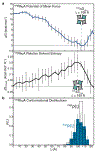Engineering the entropy-driven free-energy landscape of a dynamic nanoporous protein assembly
- PMID: 29713036
- PMCID: PMC6056010
- DOI: 10.1038/s41557-018-0053-4
Engineering the entropy-driven free-energy landscape of a dynamic nanoporous protein assembly
Abstract
De novo design and construction of stimuli-responsive protein assemblies that predictably switch between discrete conformational states remains an essential but highly challenging goal in biomolecular design. We previously reported synthetic, two-dimensional protein lattices self-assembled via disulfide bonding interactions, which endows them with a unique capacity to undergo coherent conformational changes without losing crystalline order. Here, we carried out all-atom molecular dynamics simulations to map the free-energy landscape of these lattices, validated this landscape through extensive structural characterization by electron microscopy and established that it is predominantly governed by solvent reorganization entropy. Subsequent redesign of the protein surface with conditionally repulsive electrostatic interactions enabled us to predictably perturb the free-energy landscape and obtain a new protein lattice whose conformational dynamics can be chemically and mechanically toggled between three different states with varying porosities and molecular densities.
Figures





Similar articles
-
Precise Fabrication of De Novo Nanoparticle Lattices on Dynamic 2D Protein Crystalline Lattices.Nano Lett. 2020 Feb 12;20(2):1154-1160. doi: 10.1021/acs.nanolett.9b04574. Epub 2019 Dec 30. Nano Lett. 2020. PMID: 31874042
-
Dissecting Protein Configurational Entropy into Conformational and Vibrational Contributions.J Phys Chem B. 2015 Oct 1;119(39):12623-31. doi: 10.1021/acs.jpcb.5b07060. Epub 2015 Sep 16. J Phys Chem B. 2015. PMID: 26348368
-
Entropy and surface engineering in protein crystallization.Acta Crystallogr D Biol Crystallogr. 2006 Jan;62(Pt 1):116-24. doi: 10.1107/S0907444905035237. Epub 2005 Dec 14. Acta Crystallogr D Biol Crystallogr. 2006. PMID: 16369101 Review.
-
A theoretical analysis on hydration thermodynamics of proteins.J Chem Phys. 2006 Jul 14;125(2):24911. doi: 10.1063/1.2213980. J Chem Phys. 2006. PMID: 16848615
-
Molecular Recognition in the Colloidal World.Acc Chem Res. 2017 Nov 21;50(11):2756-2766. doi: 10.1021/acs.accounts.7b00370. Epub 2017 Oct 6. Acc Chem Res. 2017. PMID: 28984441 Review.
Cited by
-
Determining the Structural and Energetic Basis of Allostery in a De Novo Designed Metalloprotein Assembly.J Am Chem Soc. 2018 Aug 8;140(31):10043-10053. doi: 10.1021/jacs.8b05812. Epub 2018 Jul 25. J Am Chem Soc. 2018. PMID: 29996654 Free PMC article.
-
Design of biologically active binary protein 2D materials.Nature. 2021 Jan;589(7842):468-473. doi: 10.1038/s41586-020-03120-8. Epub 2021 Jan 6. Nature. 2021. PMID: 33408408 Free PMC article.
-
Structural resolution of switchable states of a de novo peptide assembly.Nat Commun. 2021 Mar 9;12(1):1530. doi: 10.1038/s41467-021-21851-8. Nat Commun. 2021. PMID: 33750792 Free PMC article.
-
Protein Assemblies: Nature-Inspired and Designed Nanostructures.Biomacromolecules. 2019 May 13;20(5):1829-1848. doi: 10.1021/acs.biomac.9b00228. Epub 2019 Apr 4. Biomacromolecules. 2019. PMID: 30912925 Free PMC article. Review.
-
Asymmetrizing an icosahedral virus capsid by hierarchical assembly of subunits with designed asymmetry.Nat Commun. 2021 Jan 26;12(1):589. doi: 10.1038/s41467-020-20862-1. Nat Commun. 2021. PMID: 33500404 Free PMC article.
References
-
- Marsh JA & Teichmann SA Structure, Dynamics, Assembly, and Evolution of Protein Complexes. Annu. Rev. Biochem 84, 551–575 (2015). - PubMed
-
- Song WJ & Tezcan FA A designed supramolecular protein assembly with in vivo enzymatic activity. Science 346, 1525–1528 (2014). - PubMed
-
- Yeates TO Geometric Principles for Designing Highly Symmetric Self-Assembling Protein Nanomaterials. Annu. Rev. Biophys 46, 23–42 (2017). - PubMed
Publication types
MeSH terms
Substances
Grants and funding
LinkOut - more resources
Full Text Sources
Other Literature Sources

